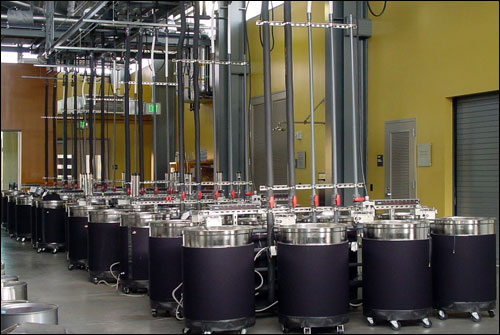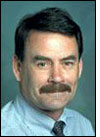After completing the fermentation process for this year’s fall wine-grape crop, the teaching and research winery at the University of California, Davis, reports that an RFID sensor system used on several dozen fermenters to measure temperature and sugar content of its wine mixes saved manual labor and provided more data about the fermenting wine than most wineries can typically gather. Next year, says Roger Boulton, a UC Davis professor who studies the chemical and biochemical engineering aspects of winemaking, the winery intends to deploy the system on all of its 152 fermenting vats.
With the data from the system, Boulton says, the winery expects to conduct testing not previously possible. Each grape mix can vary according to the type of grape used, the environmental factors in effect while the fruit was growing, and the vineyard’s location. The only way to test the different performances of various types of grapes, he explains, is to track the fermenting conditions. With a manual method of tracking fermentation, this had not been possible, but with the RFID sensor system, provided by San Jose firm Cypress Semiconductor, researchers will now have information regarding the mix’s condition, taken every five minutes.

The newly built winery is designed for student research regarding wine engineering. Each of its 152 fermenters can hold a different grape mix, to create a different wine. The fermenting process, which occurs during the first few weeks of wine production, requires monitoring of the mix’s sugar content and temperature. These levels are usually monitored manually, but in large facilities, such as that at UC Davis, gaining regular measurements of sugar content and temperature at each vat is impossible without a large staff. The manual method requires removing a lid to access the mix for measuring, which subjects the mix to potential temperature changes, oxidation and contamination. Because the researchers plan to study many different factors involved in the making of wine, based on the grape’s type and growing conditions, the winery needs to collect data frequently, in order to measure the fermentation process within each vat.
While designing the new winery, Boulton searched for a wireless monitoring system and came upon a solution that Cypress designed to track wine conditions using RFID (see Boutique Winery Believes RFID Offers a Barrelful of Benefits). Cypress’ team of engineers developed a solution for Boulton that includes sugar and temperature sensors connected to RFID nodes that transmit sensor data to a reader (which the winery calls a hub), integrated in a dongle that plugs into a USB port on a laptop. In that way, he says, the laptop receives the data and forwards it to Sense and Control Dashboard software, also provided by Cypress, via a Wi-Fi connection.
The solution went live in September 2010, with the winery’s first grape harvest, to track the conditions within 30 to 50 fermenters. The system consists of Brix sensors, used to determine the sugar content in wine. A 20-inch steel tube, containing the Brix and temperature sensors, is inserted into the vat, with the sensors wired to an electronic module mounted to the outside of the vat. The module receives the sensor measurements, displaying them on a small screen, and shares that data with an active RFID tag wired to it. The tag is connected to a power adapter plugged into an AC outlet, already installed for each fermenter’s pump.
Every five minutes, the RFID tag emits a 2.4 GHz signal encoded with its own unique ID number, as well as sensor data. The tag, which employs a proprietary RF air interface, has a read range of up to 400 meters (1,312 feet) with a clear line of sight to a reader, or approximately 100 meters (328 feet) in the presence of large amounts of steel and liquid—as is the case in this application.The transmission is received by the RFID reader plugged into a laptop, and the data is forwarded to the Sense and Control Dashboard software, residing on the UC Davis server. The dashboard displays the most recent temperature and sugar content reading for each vat, and maintains a history of measurements. Although the software could issue alerts in the form of an e-mail or text message if a threshold is crossed, at present, it simply displays the alert on the dashboard. As such, the winery’s staff must log in remotely via the Internet, or view a 46-inch video monitor on-site (provided by Cypress), that is plugged into the laptop and displays data in real time.
Shortly before the system went live, the winery asked Cypress if water temperatures leading into and out of the building could be measured as well. Cypress spent two weeks designing a system of RFID sensors for measuring the water temperature within pipes mounted on the ceiling, as hot and cold water enter and leave the facility. This helps the winery monitor the condition of water going into and coming out of the vats. The incorrect temperature going in could affect the wine’s quality, while the wrong temperature coming out could indicate a problem with one of the vats. Like the fermenter’s sensors, the Cypress water sensors are connected to active RFID tags that transmit the temperature data, along with a unique ID number, and are read by the hub reader.
The greatest challenge for this installation, according to Archana Yarlagadda, Cypress’ senior applications engineer, involved ensuring that the reader could receive the transmissions of every RFID tag in an environment filled with steel and liquid. The vats’ widespread placement, she says, necessitated a significant read range. The problem was resolved, in large part, by adjusting the tag’s position to ensure it had the best orientation of its antenna relative to the reader.
Next year, Yarlagadda says, the winery intends to have the system go live with all 152 vats, which may require more than one hub, to ensure that each tag’s signal can be received in the event that the distance from a single reader is too great.
Boulton is enthusiastic about the data the system provides—which, he notes, is more than any other winery of this scale has access to. “Do must winemakers measure the sugar content in their fermenters?” he asks. “Yes, but not very well. It needs to be done manually.” What’s more, he says, it’s unlikely that most wineries have a large enough staff to measure the mix more than once or twice daily. “We’ve depended on this system this year,” he says of the Cypress wireless nodes, “and we’re happy with the precision and accuracy.” In the future, he adds, “our issue will be filtering out some of the data,” since measurements from each vat, taken every five minutes, might provide more data than the winery requires.
“It’s created an enormous labor savings,” Boulton states, but the other benefits are no less important—namely, ensuring that temperatures are tracked more precisely, and enabling experiments on a variety of grapes that could not have been conducted in the past. “It allows us to get to work on experiments, and not worry about the manual tasks of winemaking [such as manually taking measurements at each fermenter].”


